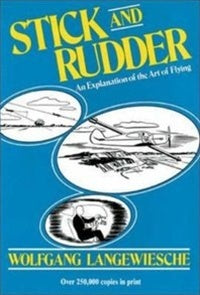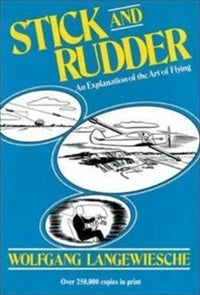
Stick and Rudder An Explanation of the Art of Flying
WHAT'S IN STICK AND RUDDER:
- The invisible secret of all heavier-than-air flight: the Angle of Attack. What it is, and why it can't be seen. How lift is made, and what the pilot has to do with it.
- Why airplanes stall How do you know you're about to stall?
- The landing approach. How the pilot's eye functions in judging the approach.
- The visual clues by which an experienced pilot unconsciously judges: how you can quickly learn to use them.
- "The Spot that does not move." This is the first statement of this phenomenon. A foolproof method of making a landing approach across pole lines and trees.
- The elevator and the throttle. One controls the speed, the other controls climb and descent. Which is which?
- The paradox of the glide. By pointing the nose down less steeply, you descend more steeply. By pointing the nose down more steeply, you can glide further.
- What's the rudder for? The rudder does NOT turn the airplane the way a boat's rudder turns the boat. Then what does it do?
- How a turn is flown. The role of ailerons, rudder, and elevator in making a turn.
- The landing--how it's made. The visual clues that tell you where the ground is.
- The "tail-dragger" landing gear and what's tricky about it. This is probably the only analysis of tail-draggers now available to those who want to fly one.
- The tricycle landing gear and what's so good about it. A strong advocacy of the tricycle gear written at a time when almost all civil airplanes were taildraggers.
- Why the airplane doesn't feel the wind.
- Why the airplane usually flies a little sidewise.
- Plus: a chapter on Air Accidents by Leighton Collins, founder and editor of AIR FACTS. His analyses of aviation's safety problems have deeply influenced pilots and aeronautical engineers and have contributed to the benign characteristics of today's airplane.
Stick and Rudder is the first exact analysis of the art of flying ever attempted. It has been continously in print for thirty-three years. It shows precisely what the pilot does when he flies, just how he does it, and why.
Because the basics are largely unchanging, the book therefore is applicable to large airplanes and small, old airplanes and new, and is of interest not only to the learner but also to the accomplished pilot and to the instructor himself.
When Stick and Rudder first came out, some of its contents were considered highly controversial. In recent years its formulations have become widely accepted. Pilots and flight instructors have found that the book works.
Today several excellent manuals offer the pilot accurate and valuable technical information. But Stick and Rudder remains the leading think-book on the art of flying. One thorough reading of it is the equivalent of many hours of practice.
From the Back Cover
WHAT'S IN STICK AND RUDDER:
* The invisible secret of all heavier-than-air flight--the Angle of Attack. What it is, and why it can't be seen. How lift is made, and what the pilot has to do with it.
* Why airplanes stall
* How do you know you're about to stall?
* The landing approach. How the pilot's eye functions in judging the approach. The visual clues by which an experienced pilot unconsciously judges: how you can quickly learn to use them.
* "The Spot that does not move." This is the first statement of this phenomenon. A foolproof method of making a landing approach across pole lines and trees.
* The elevator and the throttle. One controls the speed, the other controls climb and descent. Which is which?
* The paradox of the glide. By pointing the nose down less steeply, you descend more steeply. By pointing the nose down more steeply, you can glide further.
* What's the rudder for? The rudder does NOT turn the airplane the way a boat's rudder turns the boat. Then what does it do?
* How a turn is flown. The role of ailerons, rudder, and elevator in making a turn.
* The landing--how it's made. The visual clues that tell you where the ground is.
* The "tail-dragger" landing gear and what's tricky about it. This is probably the only analysis of tail-draggers now available to those who want to fly one.
* The tricycle landing gear and what's so good about it. A strong advocacy of the tricycle gear written at a time when almost all civil airplanes were taildraggers.
* Why the airplane doesn't feel the wind. Why the airplane usually flies a little sidewise.
* Plus: a chapter on Air Accidents by Leighton Collins, founder and editor of AIR FACTS. His analyses of aviation's safety problems have deeply influenced pilots and aeronautical engineers and have contributed to the benign characteristics of today's airplane.
FLAP COPY
STICK AND RUDDER is the first exact analysis of the art of flying ever attempted. It has been continously in print for thirty-three years, and has enjoyed steadily increasing sales. Flight instructors have found that the book does indeed explain important phases of the art of flying, in a way the learner can use. It shows precisely what the pilot does when he flies, just how he does it, and why.
These basics are largely unchanging. The book therefore is applicable to large airplanes and small, old airplanes and new, and is of interest not only to the learner but also to the accomplished pilot and to the instructor himself.
When STICK AND RUDDER first came out, some of its contents were considered highly controversial. In recent years its formulations have become widely accepted. Pilots and flight instructors have found that the book works.
Today several excellent manuals offer the pilot accurate and valuable technical information. But STICK AND RUDDER remains the leading think-book on the art of flying.
One thorough reading of it should be the equivalent of many hours of practice.
We have moved!
Downunder Pilot Shop has recently merged with Concept Aviation and moved both companies into a new retail & warehouse location in Bankstown Aerodrome. See the Contact Us page for more info.
We proudly use Australia Post
95% of orders are shipped out on the same day when made before 4pm AEST.
Shipping Costs:
Local Sydney* shipping: $9.95 flat rate
Rest of Australia, based on order value:
Under $20 - $15.95
$20 - $99.99 - $12.95
$100 - $199.99 - $10.95
Over $200 shipping is FREE!
Domestic Delivery Times:
1-3 days for most Metro deliveries
3-7 days for rural deliveries
Can be up to 10 days for very remote areas of Australia
Pickup
You can pickup your order from our store at Bankstown Aerodrome, NSW. See Contact Us page for our location and opening hours.
PO Boxes
We can deliever to PO Boxes with Australia Post
International Shipping
shipping will be calculated at the checkout.
All duty and customs charges are the responsibility of the customer
Go to: Shipping Policy page
*Local Sydney shipping is based on a 35km radius from our location. This covers most of metro Sydney.

If you are not absolutely happy with your purchase you have 30 days to return the item(s) back to us for an exchange or store credit.
3 Easy Steps
Step 1 | Submit a return request (RMA) contact us
Step 2 | Follow the shipping instructions that will be emailed to you.
Step 3 | Your return will be processed within 3 business days of being returned to the Downunder Pilot Shop.
What can be returned?
All your products are returnable, except for the usual exceptions, DVD's, underwear, software, all Jeppesen electronic and paper chart products and any products marked as "Special Order".
Refunds
We do not offer refunds if you got what you asked for but simply changed your mind, found it cheaper somewhere else, decided you did not like the purchase or had no use for it. But you are able to exchange unwanted items for store credit.
See our Terms and Conditions for more on returns.
